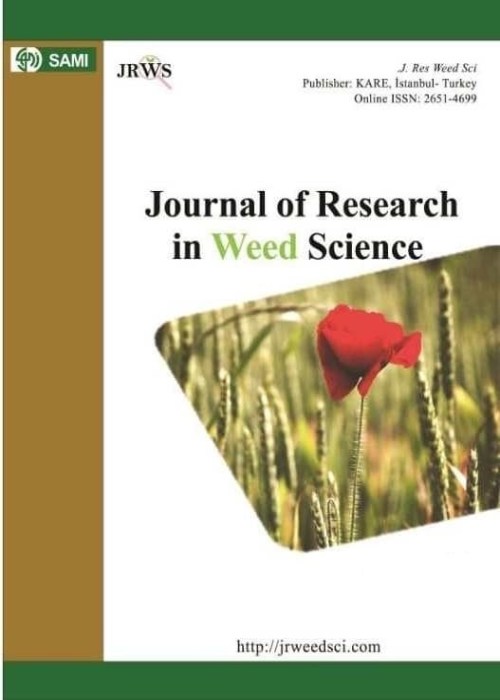فهرست مطالب
Journal of Research in Weed Science
Volume:5 Issue: 3, Sep 2022
- تاریخ انتشار: 1401/06/10
- تعداد عناوین: 2
-
Pages 118-125
Mulching is a recommended cultural practice for weed growth suppression and soil and moisture conservation in newly planted tea lands. However, tea growers have neglected this practice due to the scarcity of thatching materials like Cymbopogon confertiflorus (Mana grass) and the high labor cost. Hence, it lasted too long to explore the feasibility of using alternative sources. Furthermore, any used material as mulch should be more durable. An investigation was conducted to find low-cost and durable alternative plant materials such as tertiary shoots of Diyapara (Dillenia suffruticosa), Flemingia congesta, and Acacia auriculiformis, together with black/silver polythene mulch that were field-tested against C. confertiflorus grass mulch. Mulch was applied to tea plots at 1.0 kg m-2 on a dry weight basis. The experiment was laid out in a Randomized Complete Block Design with four replicates. The results showed that C. confertiflorus mulch was retained on plots for 18 weeks and F. congesta and A. auriculiformis were disappeared in 20 weeks after mulching, but D. suffruticosa and Agricultural mulch were remained occurring at only 85% and zero ground exposure reporting the highest weed growth suppression by 52% and 100%, respectively compared with C. confertiflorus. Weed growth was suppressed by 18% and 14% when mulched with A.auriculiformis and F. congesta compared with Cymbopogon confertiflorus. Tea growth was not affected by any mulch treatment. D. suffruticosa and agricultural mulch were more durable and promising mulches, while F. congesta and A. auriculiformis can be further used as alternative mulches to Cymbopogon confertiflorus to suppress the weed growth in newly planted tea fields.
Keywords: Mulching, Mulch durability, Tea, Weed growth suppression -
Pages 126-136Avoiding the negative effect of herbicide residues in soils on the growth of subsequent crops is especially challenging in intensive cropping sequences involving numerous crop species and short fallow periods between crops. For intensive rice cropping patterns in Bangladeshthe residual effect of six herbicides: glyphosate, pendimethalin, ethoxysulfuron-ethyl, carfentrazone-ethyl + isoproturon, isoproturon, and fenoxaprop-p-ethyl were investigated in the following crops of mungbean and mustard through plant bioassay approach. These herbicides in ten different combinations were applied to mustard, mungbean, summer rice, winter rice, and wheat in an on-farm Conservation Agriculture experiment, which was conducted for three consecutive years (2013–2016). No detrimental residual effects of any herbicides applied to the prior crops in the rotation were detected on the plant population, root, shoot growth, and chlorophyll content in the leaves of test crops. Moreover, plant biomass, seed production, and the germination rate of the harvested seeds of both crops were not hampered by the residues of tested herbicides. It is concluded that these six herbicides examined for controlling weeds in the prior rice, wheat, mustard, and mungbean crops under the minimum soil disturbance and crop residue retention could be considered safe for cultivating crops in the next season. Under the increased prevalence of herbicide use for controlling weeds in intensive rice-based cropping sequences in South Asia, the systematic assessment of herbicide residual risk to crops needs to be instituted as a routine practice in this region.Keywords: Chlorophyll, degradation, Half-life, Persistence, Phytotoxicity


